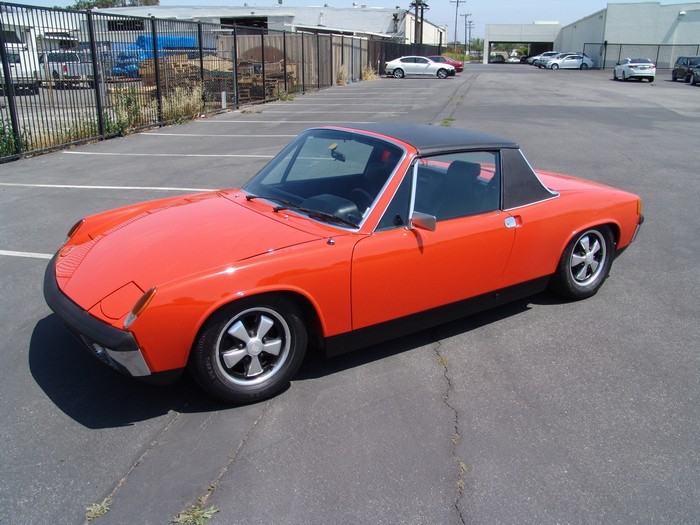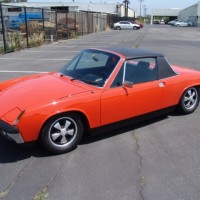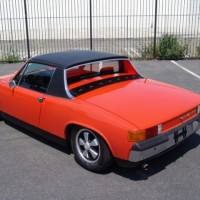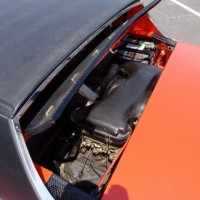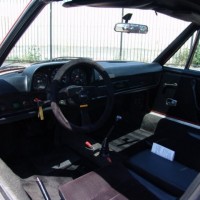• The ultimate, best-performing Porsche 914 model
• Well known in PCA circles; 30 years of single ownership
• Excellent older restoration; rare and powerful mid-engine Porsche
• Complete with toolkit and owner’s manual
SCM Analysis
Detailing
| Vehicle: | 1970 Porsche 914/6 |
| Number Produced: | 3,338 |
| Original List Price: | $5,999 East Coast; $6,099 West Coast |
| Tune Up Cost: | About $800 with valve adjustment |
| Chassis Number Location: | Stamped into front fender; tag on right headlight bucket; tag on A-pillar |
| Engine Number Location: | Vertical stamping on fan stand |
| Club Info: | Porsche Club of America |
| Website: | http://www.pca.org |
| Alternatives: | 1970 Datsun 240Z, 1970 MGB GT, 1970 Lotus Europa |
This car, Lot S651, sold for $57,750, including buyer’s premium, at Russo and Steele’s Newport, CA, auction on June 22, 2013.
For readers who are accustomed to thinking of 914s as Volkswagens minus two seats, this sales result might come as a shock. But to aficionados who appreciate the differences between a 914/4 and a 914/6, that result was not a surprise.
The 914 was the result of a well-known collaboration between Porsche and VW. Each company needed a new sports car: Porsche to replace the 912 as its entry-level car and Volkswagen to replace the moribund Karmann Ghia 1500 Type 3 and move upmarket. Volkswagen wanted to burnish its image and add panache to its dependable — but hardly inspiring — product line.
Enter mid-engine street cars
Porsche and VW had a business relationship dating back to 1948, when VW agreed to pay royalties to Porsche for the design of the VW Beetle. In that deal, Porsche contracted to do engineering projects for VW. Twenty years later when the 914 project was broached, mid-engine sports cars were just beginning to be seen at car shows and on the street.
Porsche had designed mid-engine race cars going back to the Auto Union “Silver Arrows” of the 1930s. The 1948 Porsche prototype — and all of Porsche’s racing cars of the 1950s and 1960s — were mid-engine cars. Conversely, Porsche’s and VW’s production cars were all rear-engine because the judgment had always been that even vestigial back seats were necessary to sell cars in volume. With Ferrari’s Dino, Lamborghini’s Miura and the DeTomaso moving forward, the time seemed ripe to introduce a mid-engine German sports car.
Penned largely by the industrial-design firm Gugelot of Neu-Ulm, with many compromises and refinements by Porsche’s engineers, the final 914 design was a mix of performance and practicality. Although rectangular, the car was low, with air drag equal to a 911. It had storage both front and rear for 16 cubic feet of “stuff.” The hard shell, non-folding, Targa-style top also fit into the rear compartment. It was as rigid as a 911 coupe and more rigid than a 911 Targa.
With performance tires, the 914 would pull 1.0 g on the skid pad, something no 911 did until the 1973 Carrera RS. The bodies were built at the Karmann factory, which was a trusted supplier to VW and Porsche. The 914/4s were completely assembled at Karmann, while the 914/6s left Osnabruck as tubs to go to Stuttgart for assembly on the same production line as 911s.
Both a VW and a Porsche
The 914 was designed to accommodate both a new VW engine and an existing 911 unit. The VW powerplant was the 1.7-liter, electronic fuel-injected, flat 4-cylinder engine of 85 horsepower designed for the Type 411. The engine was later built out to 1.8 and 2.0 liters.
Porsche’s engine was the 2.0-liter, 130-horsepower, Weber-carbureted 6-cylinder taken from the 911T. The 914 had lightly modified Porsche front suspension and steering. Porsche’s torsion-bar suspension could not be adapted to the rear of the car, however, as the engine was very much in the way. Thus, the 914 became the first street Porsche with a coil-over rear suspension.
The gearbox was a flipped-over Type 901 5-speed unit from the 911. 914/4s used four-stud hubs and wheels, VW front brakes, and newly designed rear disc brakes, while 914/6 cars used typical Porsche five-stud units and Porsche brakes.
The interior of the car was functional, with a large, three-dial dashboard and a wide area between the seats that, with a cushion added, would lead to the car being occasionally called a three-seater. The passenger’s seat was fixed, while the driver’s seat had seven inches of travel with just four fixed settings for height/rake, necessitated by the engine bulkhead right behind the seats. The passenger’s seat was made to match in 1972.
Never a Porsche emblem
While the 914 was under development, there was a major management change at VW. The 914 project was caught up in it. Out of that upheaval came the new worldwide VW-Audi-Porsche distribution system, including Porsche-Audi of America, significantly higher priced tubs for Porsche’s 914/6, and VW-Porsche as the brand name for all 914s — except in the United States, where the distributor fought hard to use only “Porsche.”
The 914 never had a Porsche hood emblem, although many were added by owners. P-O-R-S-C-H-E letters were placed across the engine lid just behind the rear windscreen and a unique “VW-Porsche” nameplate was on the face of the rear lid in Europe.
The 914 was introduced to the world at the Frankfurt Auto Show in September 1969. Initial U.S. distribution of the 4-cylinder car began in January 1970, and the 6-cylinder car followed in March.
The road testers had a field day with the 914/4. At best, most considered it to be a superior VW but a truly inferior Porsche. The interior — and especially the shifter — were roundly panned. The exterior styling drew mixed reviews, with more boos than huzzahs. A lower-priced, decontented Porsche was not a viable option for the motoring press.
The 914/6 was better received, but broadly considered a bad alternative versus spending only $500 additional for the more highly developed 911T. 914/4s weighed in at 1,980 pounds and 914/6s at 2,070. Initial U.S. pricing was $3,575/$3,675 (East Coast/West Coast) for the 914/4 and $5,999/$6,099 for the 914/6.
One 914 succeeded and one failed
First-year 914/4 sales were about 50% of expectation overall, and they were even worse for the 914/6. For its lifetime through the 1976 model year, however, the 914/4 sold more than 125,000 cars, with a high of 27,660 in 1973. Despite its shaky beginnings, the 914/4 was considered a success.
Not so the 914/6. After building 3,338 production cars in 1970–72, 2,657 in 1970, 432 in 1971, and 249 in 1972, the 914/6 quietly slipped away. Truth be told, the 914/6 was a fine concept that appeared in the wrong environment. Its mixed parentage, unusual design elements and high price that was too close to that of a 911 all conspired to keep it from being widely accepted.
In succeeding decades the 914/6 was largely ignored as a collector car. Then, when early 911 prices took off, enthusiasts slowly turned to the 914/6 — and now many dedicated 911 collectors want a good example.
All of which brings us to our auction car. It was apparently a European model, with the VW-Porsche nameplate on the rear deck, in a very popular color: tangerine.
The car had one 30-year PCA enthusiast owner and had an older restoration. It had its owner’s manual and its toolkit. Mileage was not disclosed, nor was information on whether the engine/gearbox and body panels were original.
At the price realized, one would assume all was in order, that the car was plastic-free, and that it had not been wrecked. Two 914/6s are publicly for sale currently: a white one in North Carolina with 95,000 miles but in excellent original condition for $55,000; and a tangerine example in Denver with 57,000 miles, street-concours restored, for $65,000. Our auction car seemed to have been bought at the market. ?
(Introductory description courtesy of Russo and Steele.)
